Gemstone Enhancements: Everything you need to know
Find out what gemstone "enhancements" are and what that means to you.
One of the important things to consider in your gemstone purchases is enhancements, or “treatments” as some people call them. What does “enhancement” mean in the gem trade?
ENHANCEMENT: Any treatment process other than cutting and polishing that improves the appearance (color/clarity/phenomena), durability, or availability of a gemstone.
We are in a privileged position to understand about gemstone enhancements because we know many dealers worldwide as well as many of the people who apply the enhancements that are common in the market. Being gem cutters we almost always buy our material in the rough. This also gives us a good opportunity to identify what has or has not been done to the gem since the rough frequently shows more signs of the enhancement/treatment than a finished gem would.
Our goal is to help you better understand this question of enhancements and help you make your own decision about what degree (if any) of enhancement you find acceptable. I believe that the question of enhancement should be divided into four individual considerations. These considerations are philosophical, visual, financial and wearability / durability.
(Some of these are enhancements we refuse to carry ourselves but are providing the information since we feel it is important for your education and awareness.)
List of Gem Enhancements
Click on the enhancement name to go to the section that explains about that kind of enhancement.
| Code | Enhancement Name |
|---|---|
| N | Natural (None) |
| H | Heat |
| R | Irradiation |
| U | Diffusion |
| BE | Beryllium Diffusion |
| O | Clarity Enhancement |
| F or ASBL | Glass Filling |
| FH | Heating with Flux |
| D | Dyeing |
| C | Coating |
 Philosophical
Philosophical
Philosophically the question is, how do you feel about a gem that has been “enhanced”? This “philosophical feel” is the largest problem that most people have with gemstone enhancements. While many individuals will accept common and durable treatments as valid and reasonable, there are still those who for holistic, religious or emotional reasons want a gem that has not undergone any “improvements” other than cutting.
In this article we will explain gemstone enhancements in an effort to help you choose your own philosophical comfort level. After reading this page you should be able to make a fact-based decision about whether certain treatments / enhancements in colored gemstones are acceptable to you.
Visual Considerations
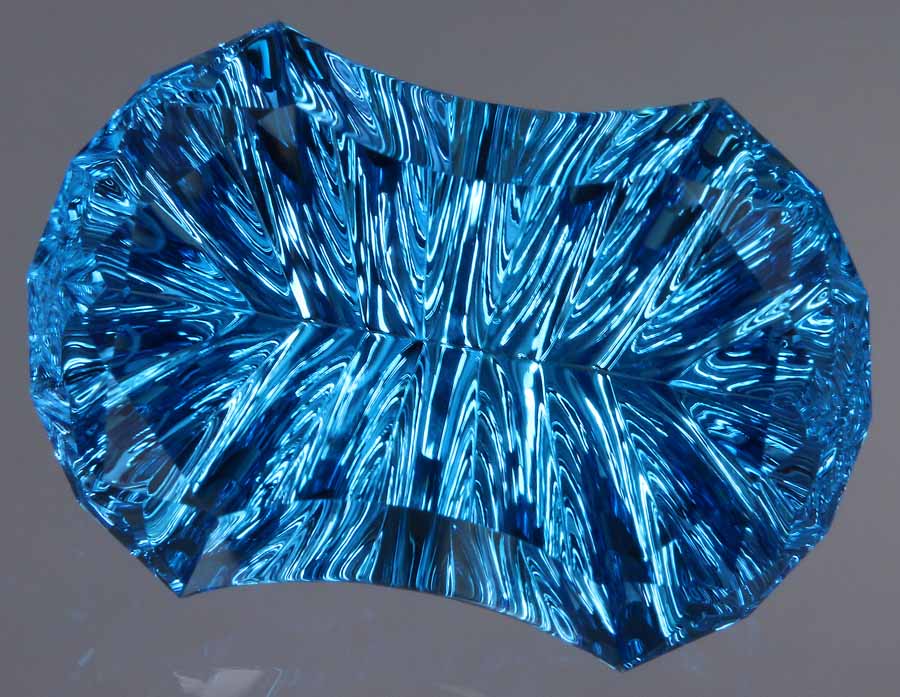
All deep blue Topaz has been enhanced to achieve this beautiful shade of blue.
Visually speaking there are some gems which can have a color or appearance after enhancement that would never be possible in the same material without enhancement. The strong rich blue of blue topaz for example would not exist if it weren’t for man’s helping hand. “Natural” blue topaz, is much lighter in color than its enhanced counterpart. The strong blue color of the enhanced topaz is a result of radiation treatment (interestingly the light blue natural topazes also experience radiation to a lesser degree while in the earth). Other gems gain some additional clarity or brilliance through a heat treatment process and yet retain a very similar color to their original “as mined” color. Since there are a variety of enhancements common in the market today, it is good to understand the different kinds of enhancements that are used on specific gems to be able to choose the best option for you. Do you prefer no enhancement at all? Is only heat enhancement acceptable to you? We hope to help you figure that out for yourself.
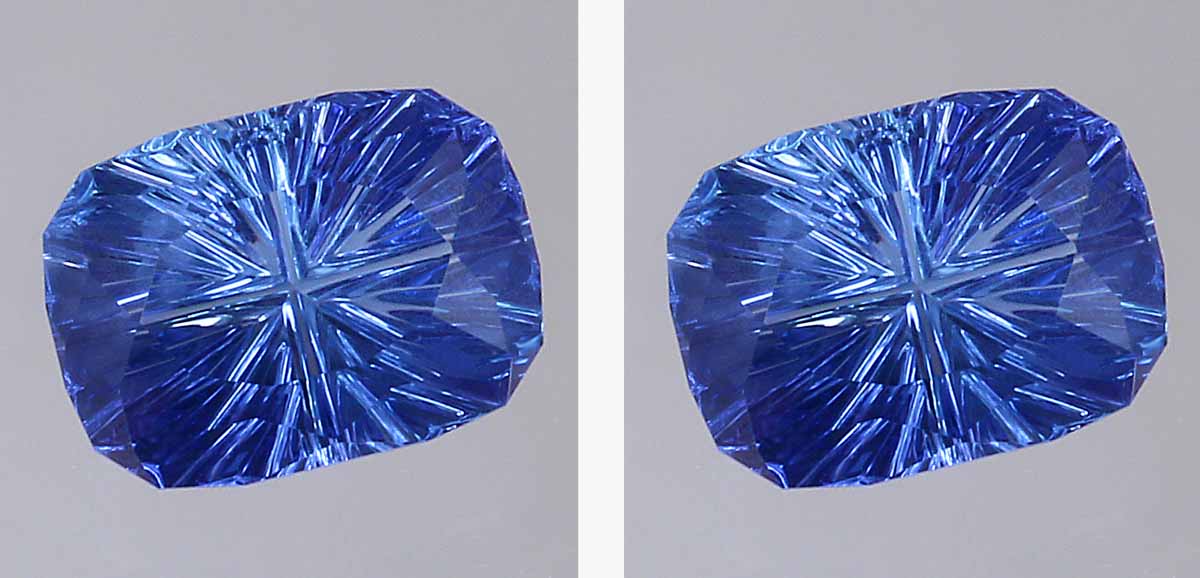
$$ or $$$
A sapphire with the exact same color will be significantly more expensive if it has not been heated.
We will explain the difference between them and allow you to decide what is best!
Financial Considerations
Financially the difference between an enhanced and un enhanced gem can be either quite large or small to non existent. Sapphires for example will usually command a 30%-80% premium if they have not been heat treated when comparing a heated one of the same color to its purely “natural” un enhanced counterpart. Why then do people ever heat sapphires? Heat will often result in a sapphire that is a different shade of color and/or clearer and consequently brighter and so certain sapphires with specific characteristics can have their beauty and salability increased by heating. If sapphire enhancement by heating does not bother you then you can get a beautiful heated gem for significantly less money than an equally beautiful one that hasn’t been heated. In other cases, such as brighter yellow or orange Citrine, heat treatment is almost universal and so the market doesn’t have a special price bracket for unheated material.
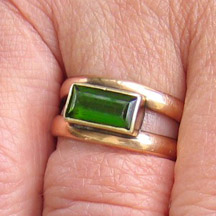
Wearability and durability
This is s also something to keep in mind with gem treatments (enhancements). There are some enhanced gem materials which are just as durable and easy to care for as their un enhanced counterparts. However, there are other enhancements which are not color stable in certain gem materials or can cause the gem to not be very durable in everyday wear. I will try to explain this as clearly as possible.
This is a list of the most common gemstone enhancements along with their “Enhancement Code”
This list also mentions the main considerations for each type of enhancement:
NONE or “NATURAL” (Enhancement code N)
This doesn’t require much explanation, but if you have any questions feel free to contact us and ask!
HEAT (Enhancement code H)
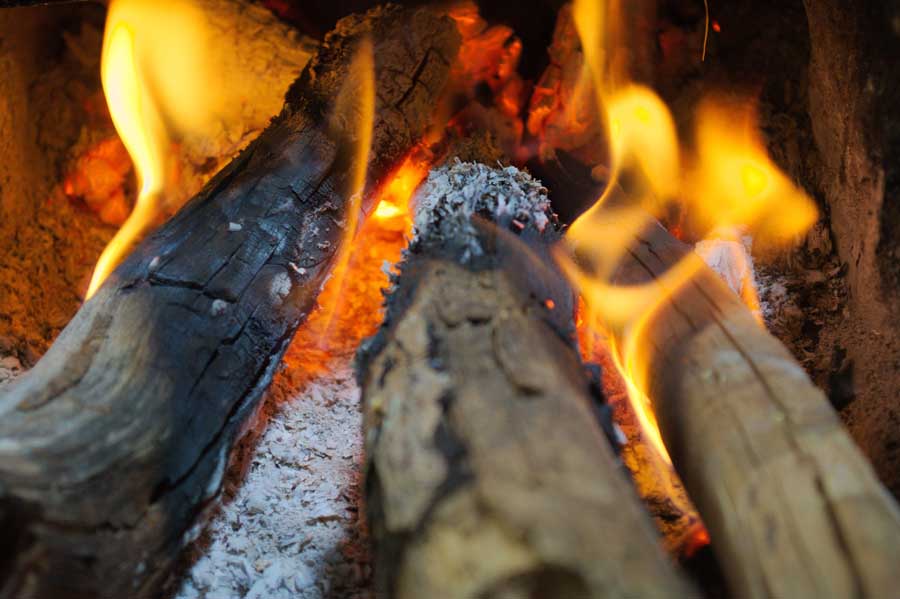
Heating is probably the oldest form of gemstone enhancement. It is impossible to tell who first allowed a gem to fall into a fire and then, in amazement, observed the resulting change of color. What is clear though is that the heating of gemstones has been going on for many centuries and, depending on the gem type, is often accepted as “routine” by those in the gem trade.
Visual: There are many gems with colors which are only possible with heat treatment. Blue Zircon for example is mined a dark red or brown color before being heated in a reducing (oxygen-lacking) atmosphere. Often this is done in a charcoal fire where all the oxygen is consumed and this heat and lack of oxygen cause the gem’s internal chemistry to “remix” itself and become a different final color. (Only zircon from certain mines will turn blue on heating.)
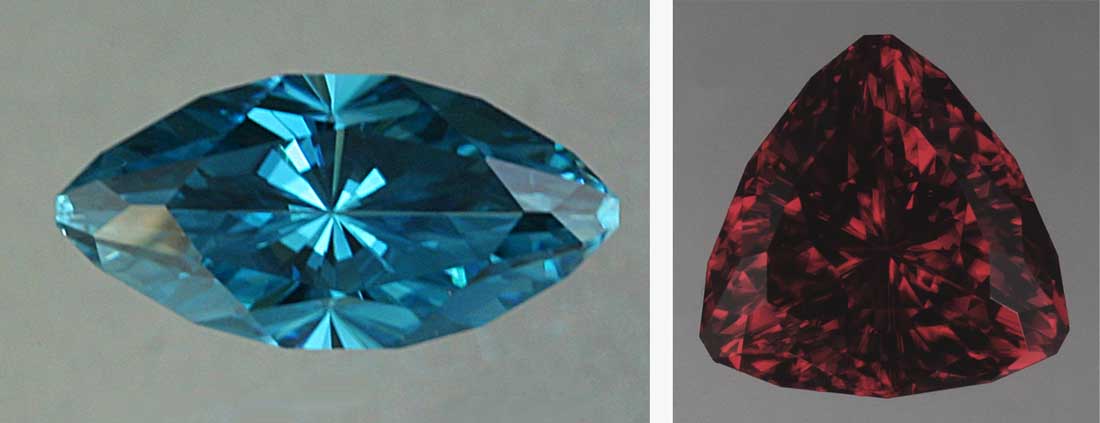
Blue Zircon is always heated from a brown, reddish or grayish color. Usually the material that heats best comes from Cambodia.
For many years Zircons were also heated until they became clear or “white” (which happens at a higher temperature) since this lack of color, combined with their great brilliance and dispersion, made them a good visual substitute for diamonds. (Zircon is a gem found in nature which should not be confused with “Cubic Zirconia,” a purely man-made diamond imitation that many confuse with Zircon due to the similarity of the name.)
Philosophical: From a philosophical standpoint heating is the most widely accepted form of enhancement in the gem trade. Heat alone does not actually add or take away anything that is in the gem’s chemistry. Even though some gems might “gain” or “lose” color from heating, this is due to the heat affecting the mixture of elements that were already inside the gemstone. The traditional process of heating of gems is widely accepted by those in the know because nothing is added or infused into the gem. This, combined with the fact that heating has been done for centuries and that it can produce colors of common gems that would not exist without man’s helping hand, make this kind of enhancement well received by the majority of the gem trade. However, there are still those who want a gem that is entirely “au naturel.”
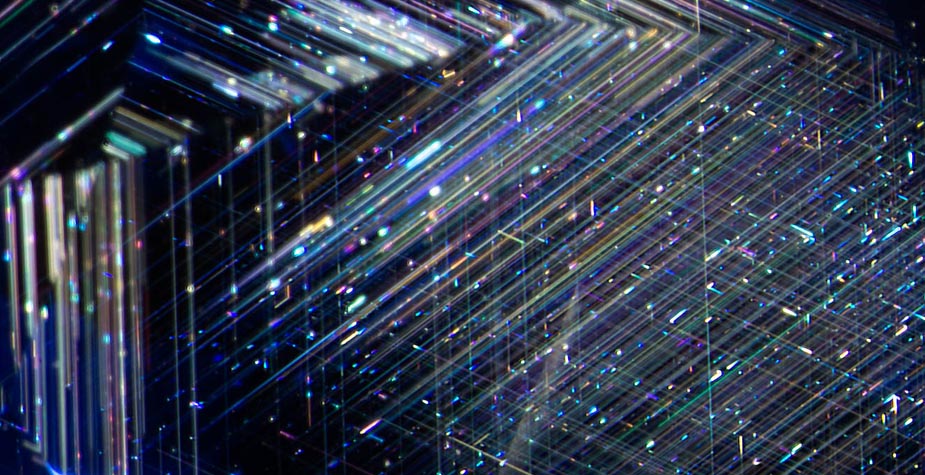
Here is a highly magnified view of natural rutile needles in an unheated sapphire. These microscopic inclusions can give a hazy or "sleepy" appearance to the untreated gemstone even though they themselves are often not visible to the naked eye.
Photo courtesy Richard Hughes/Lotus Gemology
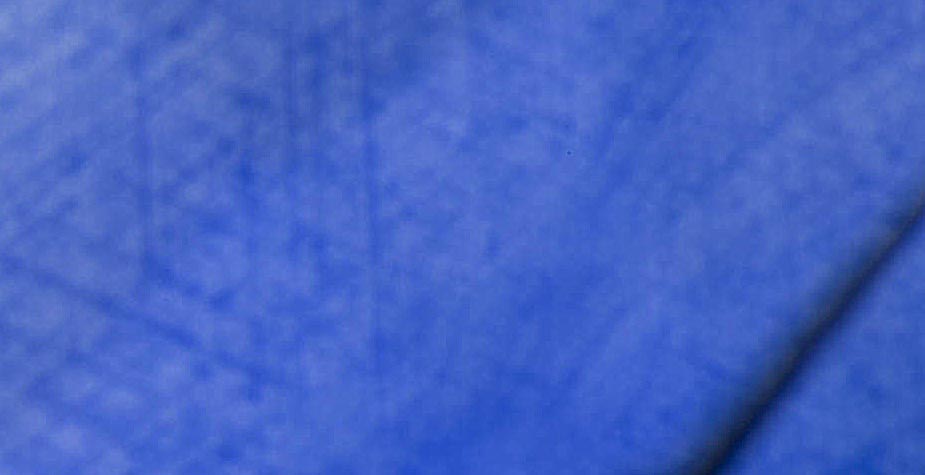
This is a magnified view of melted rutile needles in a heated sapphire. You can see how the needles are dissolved or partially dissolved and the blue color from the melted titanium (rutile) has spread out around where each needle was into the surrounding sapphire.
Photo courtesy Richard Hughes/Lotus Gemology
As already stated, heating is most often used to change the color of the gem, i.e. to make it lighter, darker, or change the color to a completely different one. Each gem material reacts in a unique way to heat depending on its chemical makeup and its gem “family.” Even the same gem material from two different mines can react differently. Heating is also used in specific gemstone types (for example Spinel and Sapphire) to improve the clarity and brilliance of the finished gem by dissolving microscopic graining or particles (especially rutile) inside the crystal.
We will not bore you here by discussing in detail what heating accomplishes in each different gem material. However, we will be happy to answer any specific questions you might have about a gem or gem material in which you are interested. Contact us here!
Financial: Heated gems are sometimes less expensive than their un enhanced counterparts. As mentioned earlier, this is especially true with Sapphires where you can get the same color gem with the same or greater brilliance for significantly less if you are willing to accept a heated gem instead of an unheated one. Other gems such as Aquamarine, Tanzanite, Tourmaline and Imperial Topaz will show very little difference in price between the heated and unheated versions of that gem variety.
Durability: Since most gem crystals were formed under high temperatures, when it comes to wearability and durability heating usually does not have a negative effect on a gemstone. Also, the color stability (resistance to fading or color changing) of heated gems is usually very good and they are super stable. The only exception we are aware of would be some Zircons, (especially lighter blue colors) a few will tend to partially revert to the old “original” color over many years or after exposure to certain kinds of ultraviolet light. (As a general rule, avoid using your gems in Nail Salons and Tanning Salons which use special kinds of light ultraviolet light to cure the fignernails or cause the skin to tan.)
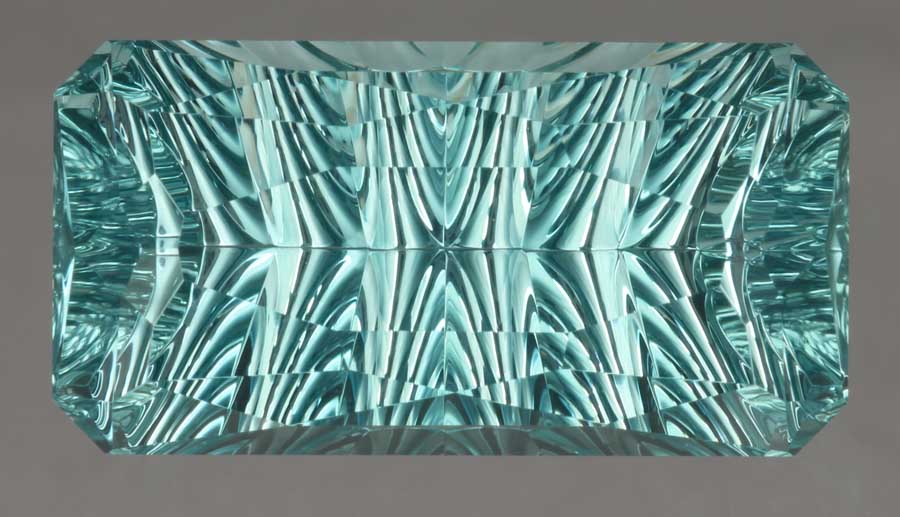
Aquamarine that has not been heated often has a greenish tint. The amount of green in an unheated aqua will vary, in some cases it might not even be visible and in others the aquamarine will be almost entirely green.
Heat treatment of some materials can usually be detected by gem laboratories. Sapphire, Ruby and Spinel have probably been studied the most since they have relatively high values and Ruby and Sapphire are often heated. Some labs, such as American Gemological Laboratories, will also make “judgment calls” upon request about whether a Tanzanite or Aquamarine is heated.
However, some gems fall into an intermediate range (lacking clear gemological signs of either treatment or no treatment) and therefore it is not possible to make an exact determination. Some materials will come back from the lab with a report stating something like this: “This color of X material is often the result of a relatively low temperature heating process”. Laboratories will often use this kind of statement, as they realize that heating is common in a certain gem type. Even in well studied gems such as Ruby or Sapphire there are a few gems where even well-respected gem laboratories can have different opinions about whether the gem has been heated or not due to a lack of clear indications in the specific gemstone.
What does "Low Heat" or "Low Temperature Heating" mean?
Sometimes gem lab reports will use this term to describe the heating done to some gems. This will usually mean heating that is done at less than 1300 degrees celsius and labs sometimes make this differentiation for several reasons. With Rubies and Sapphires "Low Temperature" heat treatment means that the gem has not reached the temperature necessary to melt rutile needles and absorb them back into the host crystal (and so improve the clarity of the gem) and it also means that the gem has not gotten hot enough that Beryllium Diffusion or other kinds of diffusion is a possibility. (Diffusion is discussed further down this page.) On many gems other than sapphires and ruby this term might be in the comments section of the lab report and say something along the lines of "This color of Tourmaline is commonly the result of a relatively low temperature heating process" (This text was taken from one of our Paraiba Tourmaline reports) and it doesn't mean much other than that ALL heating of that gem type is usually done at relatively low temperatures since super high temperatures would destroy the gem. (Sapphire and ruby can put up with much higher temperatures than most other gems.)
IRRADIATION (Enhancement code R)
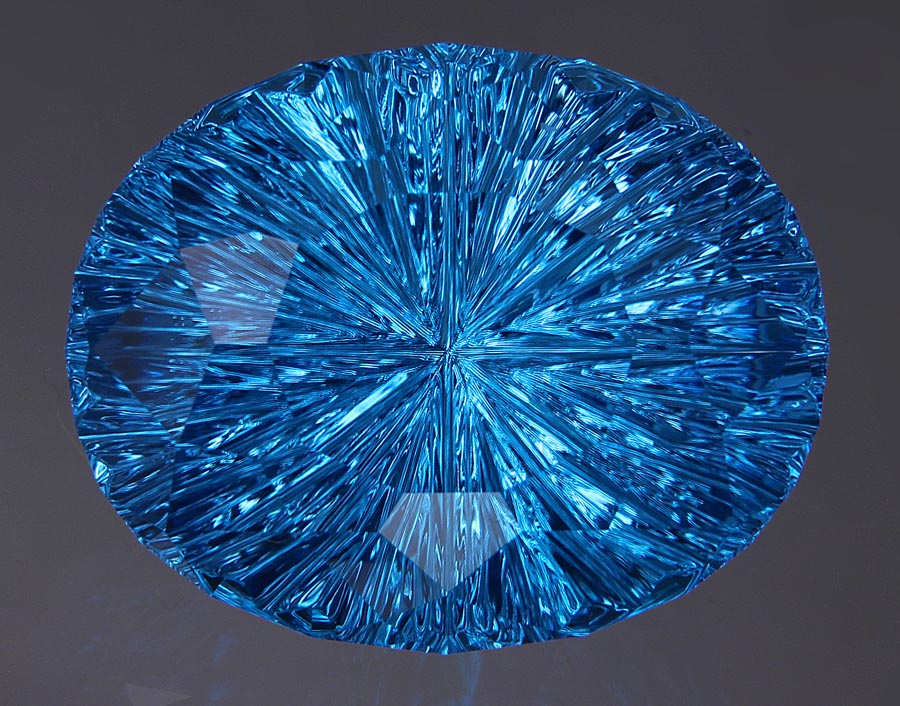
Irradiation and subsequent heat treatment is the only durable way to get this deep blue color in topaz.
The second most common enhancement on the market is irradiation. Many gems owe their color to thousands of years exposed to slight natural radioactivity in the ground where they formed. Irradiating gems after they were mined either replicates this process or takes it to another level. The gemstone “poster child” for irradiation is blue topaz. Irradiated blue topaz is so prevalent in the market that it is presumed that any topaz with a medium to deep blue color has received this treatment. Natural blue topaz does exist, but it is rare and usually such a pale blue that it can be almost hard to see the color in a small gemstone. This natural blue color is due to natural radioactivity in the place where the gems were mined. In the 1900s it was discovered that exposing topaz from some sources to commercial radiation of different kinds could deepen their color and, when coupled with heat treatment, these processes create that deep vivid blue which so many people love.
Heat treatment is often used following irradiation to drive off unstable or unwanted secondary colors from the irradiated gem. When a gem is disclosed as being irradiated (R) it is usually presumed that it has also been heated, although sometimes this heating is substituted by exposure to sunlight or some other strong light source.
“Are irradiated gems dangerous?”

Fear is usually due to a lack of knowledge and understanding. Learning about gemstone irradiation and what that means in each kind of gem will help you make a logical and safe decision.
The simple answer is NO, irradiated gems are not dangerous in the vast majority of cases. The sale and distribution of irradiated gemstones is regulated in the USA by the NRC (Nuclear Regulatory Commission) and in other countries by their specific regulatory agency. The result is that gemstones are required to be tested and have extremely low or no irradiation before being released into the market. Just as an example, the glowing numbers and pointers on your watch emit FAR more radioactivity than a legally treated gemstone. This is because the NRC radiation limits for watches (considered a useful item where jewelry isn’t) is far higher than the limits for gemstones.
Some processes which are considered “Irradiation” (such as gamma irradiation) also do not introduce any radioactivity into the gem material. However, no matter what kind of irradiation is used, all ethically treated materials are held at the treatment facility until reaching a safe level. Also, since radioactivity drops constantly over time, by the time we get around to cutting a gem the radioactivity is usually almost zero. To be extra safe (and avoid the slight possibility of purchasing rough gem material that was released too early after enhancement) we have purchased a radiation detector which we use to test all new gem rough. It is interesting when playing around with this piece of equipment to discover that virtually everything in life has a very slight radioactivity. When “testing” our own arm or other body part we often register as more “radioactive” on our radioactivity tester than most of the gems we work with.
If you are purchasing gemstones from other dealers, especially from China, Thailand or other places overseas where regulations are sometimes lax, you should have special care about purchasing “Cats Eye” Chrysoberyl as some rare cases of radiation over the legal limits have been reported.
Philosophically there is a little more resistance to irradiation in the market than there is to heat treatment, yet it is still widely accepted in certain materials. After all, if you want a topaz with a deep, beautiful and durable blue color, then accepting enhancement by irradiation is the only way you are going to get it. The philosophical resistance is due in part to the fact that irradiation is a much more recent form of gem treating than heating is and the natural nervous reaction to anything related to “irradiation”.
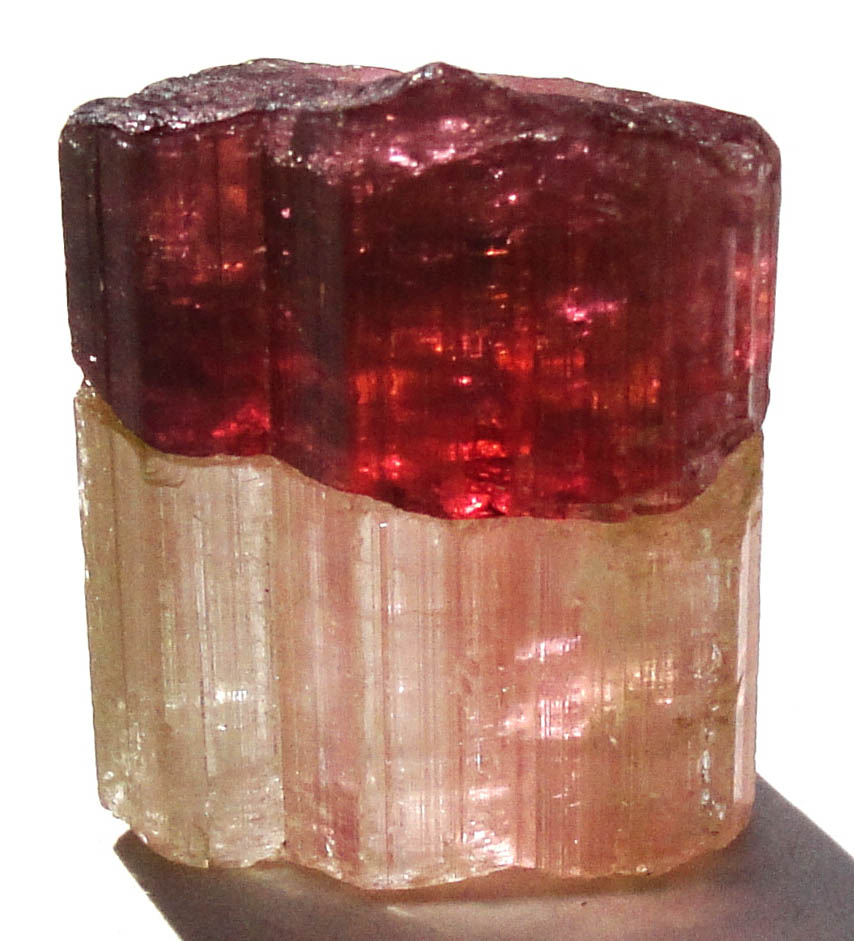
This is a tourmaline crystal which was split in half and then part of it was irradiated which resulted in a deep red color and the other part left without enhancement to show the contrast. The enhanced red color is visually identical to the color of many naturally occuring red tourmalines.
Photo courtesy of Southern California Gem Industries
As we have said, visually there are some gem color shades, like the deep blue topaz, which could never be found if it weren’t for irradiation. But there are also gems (such as Golden Beryl, Morganite, Rubelite Tourmaline, Pink Tourmaline, Kunzite, Smoky Quartz, brownish or “Cognac” quartz/citrine and others) where the irradiated version is almost visually indistinguishable or completely identical to its purely natural counterpart. In many cases these enhancements are not fully disclosed by many sellers. (We take great care to disclose ALL enhancements.)
With Golden Beryl (AKA Yellow Beryl or Heliodor) and Morganite for example I estimate that 95% or more of the material sold on the market is irradiated and often sold as natural or only “heated” by dealers who either do not know as much as they should about their product or are trying to mislead their clients. Fortunately we know the main irradiation treaters and many of the big overseas dealers personally and often have an inside view of what is being done to which gem material.
Financial considerations relative to irradiated gem materials vary considerably, some materials are almost priced the same as the non-irradiated versions, while others will be priced quite differently. We will be happy to address these questions about any specific material you might be interested in.
The durability and wearability of irradiated gemstones is also something to keep in mind. As we have already commented, they are very “safe” to wear. We have also never seen evidence of a gem being less hard or more prone to scratches or breaking due to irradiation. However, some materials that have been irradiated will be less color stable than their natural counterparts.
Gem materials that can be less color stable than their non-irradiated counterparts:
Green or Blue Beryl that has been irradiated is very “unstable” in light and can lose color quite quickly. We do not sell this kind of material. All of our Green and Blue Beryl (AKA Aquamarine) is natural or only heated, which is extremely color stable.
Kunzite, whether irradiated or not will tend to fade upon exposure to strong sunlight. Irradiated material is reported to fade more rapidly.
Irradiated gems which are relatively color stable with some exceptions:
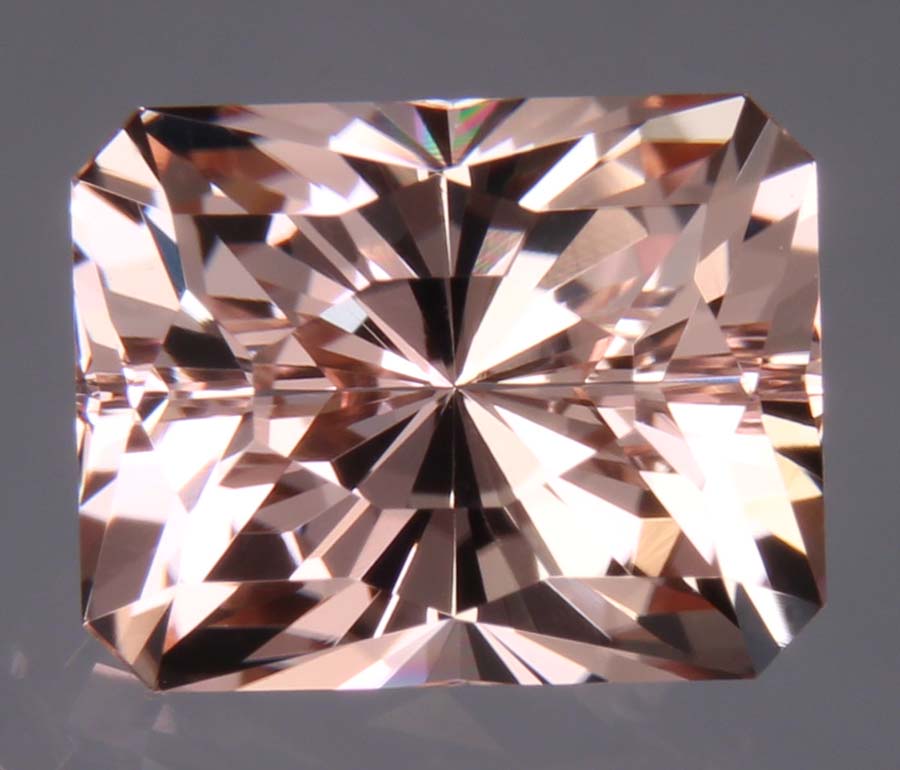
Irradiation causes a deepening of the pink color of Morganite.
Morganite is much more color stable than Kunzite, but both natural and irradiated material can fade slowly if exposed to very strong light for a long time. Some irradiated material is reported to fade faster but most of the material we carry has also been heated to high temperatures and is relatively stable. Still we do not recommend setting any kind of gem in direct sunlight for days or weeks at a time. If you wouldn’t do it to your skin why do it to your gemstones?
Golden Beryl (AKA Heliodor or Yellow Beryl). Most of the material we have has been exposed to sunlight for a while to drive off the unstable coloring. Natural un-enhanced Golden Beryl is very unusual to find because it can be heated to create Aquamarine which is more valuable. However, the natural beryl seems to be a little more color stable than the irradiated variety. (In normal use we do not expect a significant lightening of the irradiated Golden Beryl that we sell. Sometimes we have a very few natural untreated Beryls marked with an “N” for the enhancement code.)
Lime Citrine (AKA Lemon Quartz, Lime Quartz, Ouro Verde, Etc.) There are several kinds of localities (mines) for this material. We have found rough of one or two types which seem to be quite color stable. Even so, it is still not ideal to leave these gems in direct sunlight for long periods of time, just as you shouldn’t leave natural Amethyst in the sun. There are other sources which produce some pieces that tend to gradually turn a browner yellow over time. This might be accelerated by exposure to ultraviolet light. We do our best to purchase only the more color stable material. This color is not available in natural untreated material.
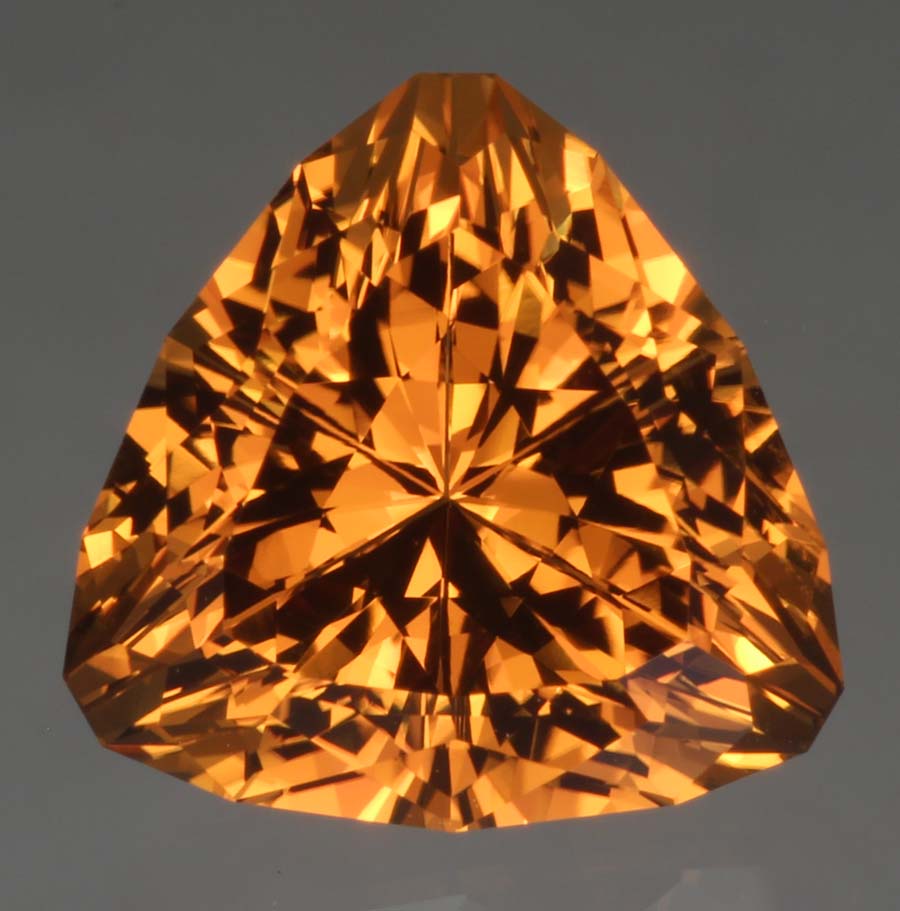
Cognac Citrine Super Trillion cut.
Cognac Citrine, Prasiolite and other quartz family gems. Most of these seem to have reasonable color stability. Just as with natural Amethyst, long (weeks at a time) exposure to direct sunlight is not recommended, but overall the color stability seems to be pretty good.
Red (Rubelite) and Pink Tourmaline which have been irradiated appear to be very color stable. Most of this material which we purchase has not been irradiated, but we have heard no reports of fading of the irradiated material.
Blue Topaz, this is the most commonly irradiated gem, and also one of the most popular gems on the market! For the most part the color is quite stable, besides being beautiful. With so many people purchasing this gem it would soon be evident if there were significant problems with the color stability.
Is there a material I forgot mention here? Ask us about it!
DIFFUSION (Enhancement code U)
We do not carry material treated in this manner. It is included here for purely educational purposes.
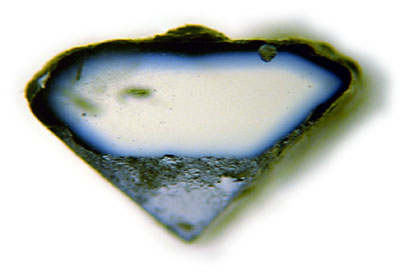
A sliced section of surface diffused sapphire showing how the coloration is only near the surface.
Photo courtesy Wimon Manoratkul
Diffusion is a process where gems are heated and an external element or elements are “diffused” into the host gem material. This treatment is less accepted in the market because an external “ingredient” or “ingredients” are introduced into the gem to change its color. Also, since many diffusion techniques leave only a thin diffused layer near the surface of the gem, the color may be partially or totally lost if the gem is recut or re-polished. Today this process is used primarily in Sapphire and Andesine-type feldspar.
Sapphire diffusion was first developed to create deep blue sapphires from relatively light or colorless sapphire material. The heating and subsequent diffusion of the added materials gave them an attractive appearance. However, the relatively large size of the atoms in the diffused elements kept them from penetrating very deeply into the crystal lattice of the sapphire. In Andesine feldspar however, there was success diffusing copper almost all the way into the very center of the gem due to crystal lattice faults typical of feldspar.
Although a diffused gemstone can be an option for those on a very tight budget, the gem trade as a whole is not very accepting of such material and we avoid dealing in it.
Reputable gem laboratories have a relatively easy time identifying standard diffused sapphires due to their shallow color rind. Detecting diffusion in Andesine can require more advanced equipment only found in the larger gem labs.
BERYLLIUM DIFFUSION (Enhancement code BE)
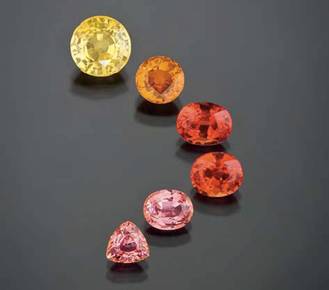
These are typical colors of Beryllium diffused Sapphire, the often tend to be more in the yellow, orange or red hues but this enhancement has also been used in other shades.
Photo by Robert Weldon, courtesy GIA
(Sometimes also disclosed as "U" by some dealers, but we and many other dealers feel it should be differentiated from the older "surface diffusion" technique which has minimal surface penetration. Because of this we use the enhancement code "BE". Beryllium Diffusion [or diffusion with other light elements] can often have far greater penetration and as a result it can be harder to identify and often has much greater durability.)
The use of Beryllium as a diffusion material (as opposed to Titanium and the other older sapphire diffusion materials) was a revolution in the diffusion treatment of sapphire because Beryllium is a “light” element with a very small molecular size that penetrates more easily into the crystal lattice of sapphire and ruby. This allows a far deeper penetration than the original diffusion process and therefore a more durable final result. This means that Beryllium diffused gems can often (but not always) be recut or re-polished without drastic changes of color.
This newer kind of diffusion treatment has achieved a slightly better market acceptance than the original kind of diffusion due to its deeper penetration into the gem. However, there is still a good bit of resistance to it by many dealers due to the fact that something is being added to the gem to change its color.
Visually speaking, beryllium enhancement can create some amazing bright yellows and pink/ orange “Padparadscha” type colors in sapphire that were not common in natural material. Other overly dark sapphire colors can sometimes be lightened.
Financially speaking, these gems are far less expensive than the natural or “heat only” sapphires of the same color. But if you ever want to resell them you will encounter more buyer resistance than with a natural or heated gem.
Beryllium treated sapphires are as hard and durable as natural ones. The enhanced color will also not bleach out or go away with exposure to light. There is still the risk, however, that if the gem ever needs a major recut, it could result in the color “changing”. This could occur if a significant amount of the outer “rim” or surface of the sapphire (which had most of the Beryllium in it) were cut away.
We have purchased only one of these gems so far with the purpose of learning about them and testing the market. Our preference is for Natural or Heat only sapphires.
Although the color of the gem is often a tip off, Gem labs often need to use more advanced testing on these kinds of gems to determine if they have only been heat treated or if they have also been beryllium diffused. Most of the major laboratories in the US can do this quite easily. (Such as GIA or AGL.)
CLARITY ENHANCEMENT BY OILING OR RESIN FILLING (Enhancement code O)

Cognac Citrine Super Trillion cut.
Ninety-nine percent of the Emeralds on the market have surface reaching flaws that have been filled with some form of oil or man-made resin to improve their appearance. Emeralds are almost always “included,” which means they have natural “flaws” (or “fingerprints” if you want to be more romantic). Emeralds are a member of the Beryl family that is colored by Chromium and/or Vanadium. Since these are relatively “large” atoms there is a theory that they don’t fit well into the Beryl crystal structure and so produce, to a greater or lesser degree, cracks, fissures or other flaws. Another theory has it that the geological conditions under which emeralds form are more “turbulent” and this gives rise to the greater number of inclusions. With the introduction of oil or some kind of resin into these cracks Emeralds and other gems with surface reaching fissures or other hollow inclusions can be made to reflect less light and be less offensive to the eye of the viewer.
Red Beryl (AKA Red Emerald or Bixbite) also often has these same kinds of inclusions, even though it is not colored by chromium. This material is often “enhanced” by the same kinds of filling treatments.
Aquamarine, Golden Beryl and Morganite which are also in the Beryl family tend to be far “cleaner” and usually do not need this kind of enhancement.
On the philosophical side, because of the predominance of this treatment in Emeralds and Red Beryl, it is very widely accepted by buyers of these materials. This kind of treatment has also increasingly been used on the more included examples of other gems such as Tourmaline, Ruby, Sapphire and almost any other material that has surface reaching inclusions. Generally market acceptance is not nearly so high for the use of this process on materials other than Emerald and Red Beryl although it is becoming more common. Finding an Emerald that has not been enhanced in this way is very difficult. Be sure to get proper disclosure on whatever gem you buy!
Visually a gem (with surface reaching fissures) that has been enhanced in this way will often look much better and cleaner than the same gem with no enhancement. The difference can often be amazing! Of course if there are no inclusions to fill, then there will be no improvement in the appearance of the gem.
Financially speaking if you want to purchase an emerald or red beryl with no enhancement you will have to look VERY hard and pay a lot more. Naturally, the less enhancement there is in specific gem the better the “quality” and the higher the price. Many gem laboratories grade the amount of clarity enhancement in a range from “None”, to “Insignificant”, “Minor”, “Moderate” and finally “Prominent”. The exact terminology can vary from lab to lab, but the intent to try and identify how much filler has been used is the same for those labs that offer this service. Since we cut the Emeralds and Red Beryls we sell and then have them enhanced, we can usually give you a good idea of how lightly or heavily enhanced a specific gem is.
Wearability and durability depend on two things. The first consideration is how much enhancing filler has been used on the gem. This is because the more filler there is the more likely the gem is to be fragile because of the underlying hidden cracks and flaws. If you can envision a gem with a crack / fissure going most of the way across it, you can no doubt see how that would likely be more fragile than a gem without a crack or with just a small one. Just because that fissure is filled with oil and therefore is less visible it doesn’t make the gem any more durable. That brings us to the second consideration.
Many so called “purists” prefer “Cedarwood Oil” as the traditional and more “Natural” treatment technique for Emerald and Red Beryl. However, oils do not add anything to the overall durability of the gem and can come out relatively easily if the gem is exposed to acetone, alcohol or heat. When the filler comes out, restoring the gem to its prior beauty requires that the gem be re-enhanced. Also, the oil filler material can change to a less transparent yellowish color over time which reduces the beauty of the gem.
There are also a variety of resins (sort of like an epoxy-type material) that do the same job of improving the transparency and luster of the gem and if hardened can often last longer than oil-based fillers. These resin-based fillers also might actually increase the strength of the material by “gluing” the gem together to a certain extent.
Some object to the concept of an enhancement using a “glue” from a philosophical standpoint. I personally think that if it works better and lasts longer, then it is better. Of course, the best option is a gem with little or no filler. The second best option (in my opinion) is a good modern resin-based filler. When we use a filler it is usually the “Excel” filler which is a polymer resin enhancement that is applied by a company in New York City and is guaranteed for life. It can be removed by the same company that applies it. The only gems for which we use this kind of enhancement are Emeralds and Red Beryls.
GLASS FILLING (Enhancement code F or ASBL)
Does it look like you found a really good deal on a Ruby or Sapphire? Be careful! Many extremely low quality rubies and sapphires are being filled with died leaded glass. The result is a HUGE improvement in the apparent clarity of the gem. This often temporarily masks enormous cracks or even glues multiple smaller rough pieces into what looks like a single larger stone which is then faceted and can look okay to the naked eye. The color of the finished “gem” (if they can be called a gem) is often primarily due to the artificial coloring present in the glass filling (or bonding agent). On the wholesale market this kind of material is priced as low as $2-$6 per carat, which shows how much it is truly worth. Once these kinds of treated stones reach the retail market they are often misrepresented and sold for far more. Be wary of super “good deals” on Rubies or Sapphires since this kind of treatment is very common.
This treatment is also not permanent. Even light household acids like lemon juice cause the corrosion of the glass filler and expose unsightly white lines where the cracks are in the gem. Many disasters also happen when jewelry containing this type of stone is taken in for repair and is either heated lightly or exposed to a form of acid that is used to clean the jewelry during the repair.
Today, rubies are both rare and expensive, if you find a cheap one be very suspicious. Gems with this kind of treatment are often being sold in large department stores and other places where you might normally expect to get a more honest representation of what you are buying. Some of their employees may be minimally trained in gemology and so pass this treated material on to the end consumer without really knowing about the treatment or just thinking it is normal.
Glass fillers will often leave bubbles in the cracks they are filling which are visible with careful examination with a loupe. A good gemologist should be able to spot them fairly easily.
Many in the trade do not consider these glass treated stones to actually be “rubies” since so much of their red color comes from the glass and also because of how much glass is in many of them. They are often referred to by knowledgable gemologists as “composite” gems. We do not sell this kind of material or approve of it. The enhancement code F is used for “filling” which would be a lesser form of this treatment, more extreme cases should probably be labeled ASBL which stands for “Assembled” since they are made up of multiple smaller pieces bonded together.
HEATING WITH FLUX “HEALING” (Enhancement code H, F or FH)
This is a process used primarily with rubies, especially those from the Mong Hsu region of Burma. The heating improves the color and transparency by dissolving minute inclusions in a similar way as traditional heat treatment. The difference lies in the addition of a fluxing agent to the heating crucible. This fluxing agent seeps into any fine cracks in the ruby (which are very prevalent in the Mong Hsu material) and lowers the melting temperature of the surface of these fine cracks causing localized melting and re-crystallization of the ruby itself in that area.
This “heals” or partially heals these fine fissures. (This technique is also occasionally used on Sapphire, but it is much more common in Ruby.) This is different from the glass filling mentioned before since this process only works with small and fine fissures. Also since it melts the ruby material itself the “healed” material is far more durable and permanent than glass filling. There is currently a US embargo on Burmese rubies. No new material is allowed to be imported from that location, which is the primary source of material enhanced in this way. However, there is still some stock of older material on the US market and occasionally this process might be used on gems from other sources, so it is something you should be aware of if you are shopping for Rubies.
The effect of this treatment on the value of a Ruby is not huge unless there are a lot of “flux healed” areas. Gems with smaller amounts of flux healing are usually priced similarly to, or just slightly lower than, regular heated rubies. Since Burma has long had a reputation for some of the most beautiful colors, that origin commands a premium which compensates at least in part for the effect that flux healing would normally have on the price.
The durability of these gems is virtually the same as natural or merely heated gems of the same kind.
DYEING (Enhancement code D)
Dyeing is when color is added to filling material (as with some low grade emeralds) or impregnated into other flaws or fissures in a gem. This enhancement is more common with non-transparent gem materials is and not something that we are comfortable with since it is often not permanent and is not well accepted by the market. Often a died gem can be soaked in alcohol or acetone and the dye will leach out into the solvent and be visible. This is one of the most basic testing techniques, but laboratories also use more advanced techniques in certain cases.
COATING (Enhancement code C)
Some gems are coated with a thin film using similar techniques to those used on computer chips. The most commonly known versions are the “Aqua Aura”, “Mystic” or “Azotic” coatings which give the gem an iridescent look. These more “metallic” coatings give a look which no natural gem has and are easily identified by those with some experience with gemstones.
There are also some cases of colored coatings applied to gems to make them appear a deeper color (like some tanzanite), or lighter (like some diamonds) and these uses are considered fraudulent. There are also cases of coating clear topaz to give it a deep red, blue or green color which, when properly disclosed, is not considered fraudulent. These coatings, when not being used deceptively, are confined almost exclusively to the low end of the market and are not something which we offer. Since we cut our own gems we can assure you that they are not coated since any coating cuts away very quickly since it is extremely thin. Any chipping or re-polishing of gems that have been coated will remove the coating and drastically change the appearance of the gem.
If you have any questions about treatments or philosophical, visual, financial, and wearability / durability issues please call or email me!
We feel that the most important factors in decisions about gemstone enhancements are an honest and accurate disclosure of what enhancements have been done and a clear explanation of what each enhancement means.
Not all sellers give this complete information, this is either to avoid possibly losing a sale or for lack of the knowledge necessary, but we disclose all enhancements using “enhancement codes” on every gem we offer. This code indicates what enhancements have been done, or may have been done, to the individual gemstone. On our website, this code includes a link to a more complete explanation about what each enhancement is and means. We are also happy to answer any further questions you may have via telephone or email. When you are in full possession of the facts, it becomes much easier to make your own decision about gemstone enhancements.
John Dyer
NOTE: SINCE WE DEAL ALMOST EXCLUSIVELY IN TRANSPARENT GEM MATERIALS (OTHER THAN DIAMONDS) WE ARE NOT INCLUDING TREATMENTS THAT ONLY APPLY TO OPAQUE MATERIALS OR DIAMONDS IN THIS LIST.

